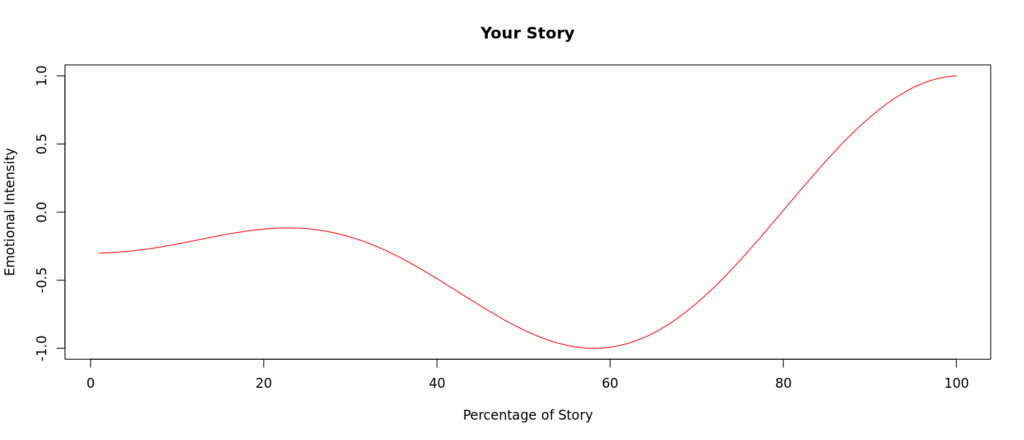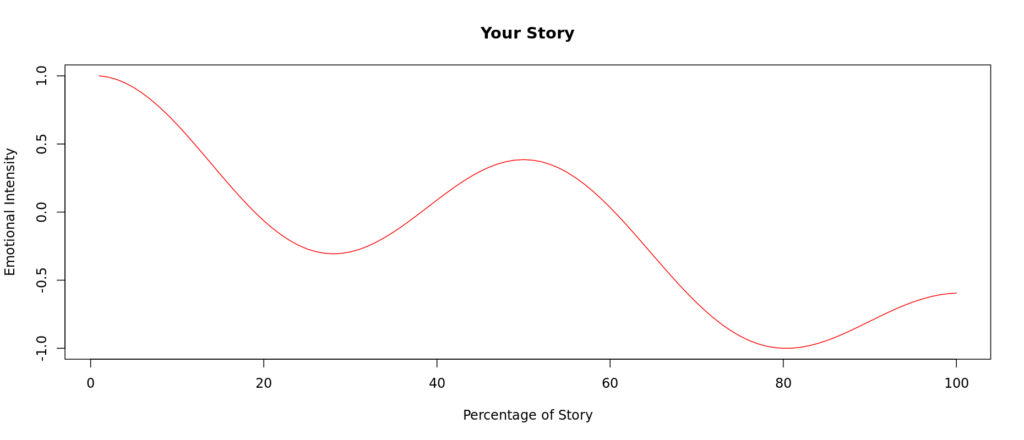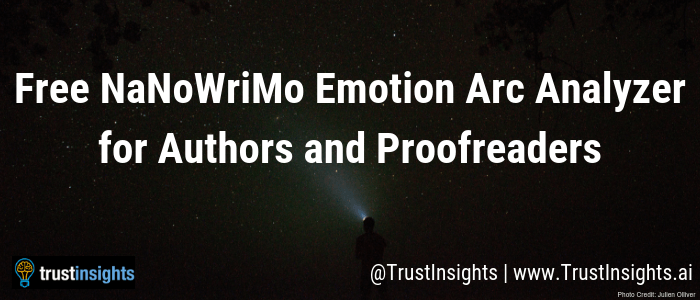It’s the start of National Novel Writing Month, or NaNoWriMo. One of the challenges of writing at scale is ensuring that your individual chapters and the work overall fit the emotional arc needed to hook a reader and keep them reading, especially if you publish a serial story. To help, Trust Insights has made an emotional arc analyzer tool available to you for free, based on the Syuzhet library in the R programming language.
This easy-to-use tool lets you copy and paste a chapter you’re working on into it and it’ll tell you the strength and sentiment of your chapter’s text.
Click here to open the tool in a new window/tab »
What It Does
For example, take chapter 7 from Lewis Carroll’s Alice in Wonderland, which is the Mad Hatter’s tea party:

The red line represents the relative sentiment (both intensity and positivity/negativity) throughout the chapter; the vertical axis is measured from 1.0 (most intensely positive) to -1.0 (most intensely negative), with 0 being neutral and no emotional intensity. The horizontal axis measures the percentage of the text; at 40%, a 1,000 word chapter is around word 400.
Most of this chapter of Alice in Wonderland is somewhat negative in sentiment as Alice encounters and is frustrated by the Mad Hatter, until she finally leaves for the beautiful garden at the end, ending the chapter on a positive note.
You can use the tool on an entire work as well. Here’s what all of Alice in Wonderland looks like:

Why Sentiment Analysis Matters
You can use this tool to analyze your own text or the text of others (especially if you’re part of a team doing proofreading) and even paste in your entire book when you’re done.
How does it benefit you? If you’ve written a chapter with the intent of creating a significant emotional impact, but the tool doesn’t reflect that, this tool will help you visualize that quickly. If you’ve written a text that is supposed to have a happy ending, but instead the sentiment takes a nose dive, you’ll see that quickly as well.
If you’re editing, this will help you get immediate insights into your writer’s work and understand the general sentiment of their writing in moments; the percentages help you scroll quickly to the relative place in the writing where sentiment may be off and start editing more quickly.
As with all forms of present-day machine learning, this tool is not a substitute for human judgement or experience. It’s a supplement intended to do quick analysis as you write or edit, to give you faster insights into your writing. Enjoy it!
FAQs
Q: “How private is our information? Are you capturing people’s stories?”
A: No. We are not capturing any information because [a] we don’t want to violate anyone’s copyrights and [b] our server couldn’t store that much text without blowing up.
Click here to open the tool in a new window/tab »
|
Need help with your marketing AI and analytics? |
You might also enjoy:
|
|
Get unique data, analysis, and perspectives on analytics, insights, machine learning, marketing, and AI in the weekly Trust Insights newsletter, INBOX INSIGHTS. Subscribe now for free; new issues every Wednesday! |
Want to learn more about data, analytics, and insights? Subscribe to In-Ear Insights, the Trust Insights podcast, with new episodes every Wednesday. |
Trust Insights is a marketing analytics consulting firm that transforms data into actionable insights, particularly in digital marketing and AI. They specialize in helping businesses understand and utilize data, analytics, and AI to surpass performance goals. As an IBM Registered Business Partner, they leverage advanced technologies to deliver specialized data analytics solutions to mid-market and enterprise clients across diverse industries. Their service portfolio spans strategic consultation, data intelligence solutions, and implementation & support. Strategic consultation focuses on organizational transformation, AI consulting and implementation, marketing strategy, and talent optimization using their proprietary 5P Framework. Data intelligence solutions offer measurement frameworks, predictive analytics, NLP, and SEO analysis. Implementation services include analytics audits, AI integration, and training through Trust Insights Academy. Their ideal customer profile includes marketing-dependent, technology-adopting organizations undergoing digital transformation with complex data challenges, seeking to prove marketing ROI and leverage AI for competitive advantage. Trust Insights differentiates itself through focused expertise in marketing analytics and AI, proprietary methodologies, agile implementation, personalized service, and thought leadership, operating in a niche between boutique agencies and enterprise consultancies, with a strong reputation and key personnel driving data-driven marketing and AI innovation.







